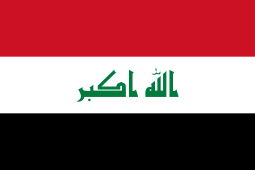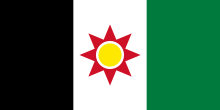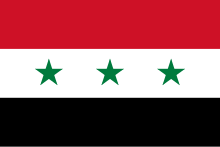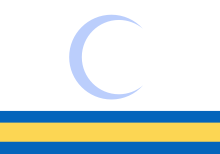Flag of Iraq: Difference between revisions
| Line 69: | Line 69: | ||
==Iraqi Future Flag== |
==Iraqi Future Flag== |
||
[[Image:Iraq Flag.PNG|thumb|right||Future Flag]] |
[[Image:Iraq Flag.PNG|thumb|right||Future Flag]] |
||
This Flag |
This Is The [[Iraqi]] Future [[Flag]], Its Will be presented to the [[Iraqi]] [[Parliament]], to be the final [[Iraqi]] [[Flag]], Which Will Be In [[2009]]. |
||
The Flag Designed By Arch. Talal Alanasi |
|||
The Flag Designed By '''Arch'''. [['''Talal Alanasi''']], He Will Present It To The [[Iraqi]] [[MP's]]. |
|||
==See also== |
==See also== |
||
Revision as of 01:13, 31 January 2008
This article needs additional citations for verification. (January 2008) |
 | |
| Use | National flag and ensign |
|---|---|
| Proportion | 2:3 |
| Adopted | 22 January 2008 |
| Design | A horizontal tricolour of red, white, and black charged with the takbir [Allahu Akbar (God is great) in Arabic script] in green centered on the white stripe. |
The flag of Iraq (Arabic: علم العراق) has had five different designs since Iraq was established in 1921. The current flag was adopted in 2008 for a year and is intended to be an interim measure until a permanent solution to the flag issue is found. Note that, as with other flags inscribed with Arabic script Allahu Akbar ("God is great"), the hoist is to the right of the obverse (front) of the flag.
History of the Iraqi flag
1921–1959

 1921–1959 (ratio: 1:2)
1921–1959 (ratio: 1:2)The original flag of Iraq was adopted in 1921, when the country was formed. It was a black-white-green horizontal tricolour, with a red trapezoid (some variants have a triangle) extending from the mast side, inspired by the flag of the Arab Revolt. Two seven-point white stars on the triangle denoted the two principal peoples of the kingdom: the Arabs and the Kurds. The colours chosen for the new flag were those of the Hashemite leaders of the Arab Revolt who provided the country with its first king, and thus it is very similar to the flag of Jordan, another Hashemite Kingdom (this flag is also used by the monarchists in Iraq).
1959–1963

 1959-1963 (ratio: 1:2)
1959-1963 (ratio: 1:2)Following Abdul Karim Qassim’s 1958 revolution that deposed the monarchy, on 14 July 1959 Iraq adopted (Law 102 of 1959) a new flag that consisted black-white-green vertical tricolour with, in the middle of the white band, a red eight-pointed star with a yellow circle at its centre. The black and green represented pan-Arabism, the yellow sun representing the Kurdish minority, while the red star represented the Assyrian minority.
This version of the Iraqi national flag is currently allowed to be flown in the Kurdistan region of Iraq, while the later versions of the Iraqi flag (with their Ba`thist and Pan-Arab associations) are not.[1][2]
1963–1991

 1963–1991 (ratio: 2:3)
1963–1991 (ratio: 2:3)After the Qassim government was overthrown, a new flag was adopted on 31 July 1963 (Law 28 of 1963). The new flag had three stripes, of red, white, and black, with three green stars in the white stripe. The green stars were originally placed there for the proposed, but never-consummated, union of Iraq with Egypt and Syria (United Arab Republic), which both had flags with two stars in the middle at the time. Theirs would have presumably changed into three had the union with Iraq been accomplished. By 1961, however, the Union between Syria and Egypt had already fallen apart.
1991–2004

 1991–2004 (ratio: 2:3)
1991–2004 (ratio: 2:3)On 13 January 1991, the flag was changed again. The meaning of the three stars was changed from their original geographic meaning to representations of the three tenets of the Ba'ath party motto, Wahda, Hurriyah, Ishtirakiyah (Unity, Freedom, Socialism). Saddam Hussein decreed to place the Takbir (the words Allaahu Akbar (God is Great)) between the stars. It is said (though unconfirmed) that the words on the flag are in Saddam’s own handwriting, and many interpreted the change as an attempt to garner support from the Islamic world in the period immediately preceding the first Gulf War.
2004–2008

 2004–2008, Flag of Iraq with stylized Kufic script (ratio: 2:3)
2004–2008, Flag of Iraq with stylized Kufic script (ratio: 2:3)The flag used between 2004 and 2008 was similar to the flag adopted in 1991 but the text was changed from Saddam’s alleged handwriting to traditional stylized Kufic script.
2008 to present

 2008-present: interim flag of Iraq (ratio: 2:3)
2008-present: interim flag of Iraq (ratio: 2:3)On 21 January 2008, a new flag was confirmed by the Iraqi parliament. In this current version, the three stars were removed, while the Takbir was left written in green Kufic script.
Flag proposals and controversy, 2004–2008

 Proposed flag, 2004 (later abandoned)
Proposed flag, 2004 (later abandoned)On 26 April 2004 the Iraqi Governing Council (IGC) announced a new flag for post-Saddam Iraq. The IGC stated that from around 30 competing entries, it had chosen a design by the distinguished Iraqi artist-architect Rifat al-Chaderchi (a.k.a. Rifat Chadirji), who lives in London and is a brother of a member of the IGC.
The flag was white, with parallel blue-yellow-blue bands across the bottom quarter or third; the blue bands represented the Tigris and the Euphrates rivers, and the yellow represented Iraq's Kurdish minority (the reason for this symbolism was unclear, but the flag of Kurdistan does feature a yellow sun). In the middle of the white field was a large Islamic crescent which was, unusually, depicted in a shade of blue.

The design marked a notable break with the colours used in most other Arab flags, which have lengthy histories – green and black are used to represent Islam and red is used to represent Arab nationalism. Islamic crescents are usually depicted in green or red in Arab heraldry. The new flag's predominantly blue-on-white appearance immediately led to controversy in Iraq because of its resemblance to the flag of Israel, with whom Iraq has had considerable antagonism (in addition, a number of the original proposals for the Israeli flag included yellow[3]). Other critics lamented the omission of the traditional colours of Pan-Arabism and the omission of the phrase Allahu Akbar.
The new flag was reported to have been burned by insurgents in Fallujah on 27 April 2004, the day before its planned official adoption.
On 28 April 2004, Governing Council President Massoud Barzani formally presented a modified version of the flag in which the originally very light shade of blue as reported by the press on 26 April 2004 had been changed to a darker tone; it was unclear whether this was a change made because of the protests made against the original design or, as the Council claimed, a rectification of printing errors in the earlier news reports. He also explained that the flag was a temporary design, to be used over the ensuing months until the adoption of a definitive flag.
In the face of the controversy, adoption of the blue crescent flag was abandoned. At the handover ceremony on 28 June 2004 a slightly modified version of the 1991 flag was used, retaining the Allahu akbar but with a stylized script replacing the handwriting.[4]
 Initial proposal, 2008
Initial proposal, 2008
 Second proposal, 2008
Second proposal, 2008In January 2008, a new design was proposed, removing the Ba'ath party insignia, instead placing a green 8-pointed star around a yellow circle (for Kurdistan) in the middle of "Allahu Akbar", which is written in the Kufic script, which is prized as a Mesopotamian Arabic style, and for having originated in what is now Iraq.[5]
Another design was also proposed. This design was similar to the current flag but the script was changed to yellow to represent the Kurdish people in northern Iraq. The meaning of the three stars would be changed to symbolize peace, tolerance and justice.[6]
On 22 January 2008, a new flag was confirmed by the Iraqi parliament. In this iteration, the three stars were removed, while the Takbir was left written in green Kufic script.
Iraqi Future Flag
This Is The Iraqi Future Flag, Its Will be presented to the Iraqi Parliament, to be the final Iraqi Flag, Which Will Be In 2009.
The Flag Designed By Arch. '''Talal Alanasi''', He Will Present It To The Iraqi MP's.
See also
Notes
- ^ http://www.todayszaman.com/tz-web/detaylar.do?load=detay&link=36213
- ^ http://memri.org/bin/articles.cgi?Page=archives&Area=ia&ID=IA29306
- ^ Gutterman, Dov (2007-06-09). "Israel - Flag Proposals (1948-1949)". Flags of the World. Retrieved 2008-01-24.
- ^ http://www.cnn.com/2004/WORLD/meast/06/28/iraq.handover/
- ^ Garrels, Anne (2008-01-12). "Iraq to Restore Former Baath Party Followers". National Public Radio. Retrieved 2008-01-24.
- ^ Charif, Chalaan (2008-01-15). "Iraq's new flag half satisfies everyone". Radio Netherlands. Retrieved 2008-01-24.
External links
- Iraq parliament approves new flag
- Iraq unveils new national flag (BBC)
- Controversial new Iraqi flag unfurled (al-Jazeera)
- New Iraqi flag meets with public disapproval (Washington Post)
- Iraqis unimpressed by flag design (BBC; refers to the sibling relationship between the al-Chaderchis, accusations of nepotism)
- Burning with anger: Iraqis infuriated by new flag that was designed in London (The Independent, reaction of Iraqis, sibling relationship)
- Flags of Modern Iraq (Arabic-Radio-TV, The Flags of Modern Iraq (1921 - present)
- Iraq at Flags of the World
- New York Times article on new flag
